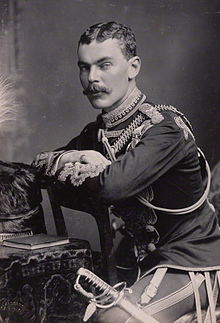David Ogilvy, 11th Earl of Airlie
The Earl of Airlie | |
|---|---|
 Lord Airlie in 1883. | |
| Born | David Stanley William Ogilvy 20 January 1856 |
| Died | 11 June 1900 (aged 44) Pretoria, South African Republic |
| Occupation | Scottish peer |
| Spouse | |
| Children | Lady Kitty Ogilvy Lady Helen Ogilvy Lady Mabell Ogilvy David Ogilvy, 12th Earl of Airlie Hon. Bruce Ogilvy Hon. Patrick Ogilvy |
| Parent(s) | David Ogilvy, 10th Earl of Airlie Hon. Henrietta Stanley |
Lieutenant-Colonel David Stanley William Ogilvy, 11th Earl of Airlie, DL (20 January 1856 – 11 June 1900) was a Scottish peer and soldier.
He was born at Florence, Grand Duchy of Tuscany. He was the third child and elder son of David Ogilvy, 10th Earl of Airlie, and The Hon. Henrietta Blanche Stanley.[1]
Marriage and family[edit]
On 19 January 1886 he married Lady Mabell Frances Elizabeth Gore, daughter of Arthur Gore, 5th Earl of Arran, and Lady Edith Elizabeth Jocelyn at St George's, Hanover Square, London, England.[1]
They had six children:
- Lady Kitty Edith Blanche Ogilvy (5 February 1887 – 17 October 1969)
- Lady Helen Alice Wyllington Ogilvy (21 November 1890 – December 1973)
- Lady Mabell Griselda Esther Sudley Ogilvy (22 January 1892 – 4 November 1918)
- Colonel David Lyulph Gore Wolseley Ogilvy, 12th Earl of Airlie (18 July 1893 – 28 December 1968)
- Hon. Bruce Arthur Ashley Ogilvy (15 March 1895 – 29 September 1976)
- Captain Hon. Patrick Julian Harry Stanley Ogilvy (26 June 1896 – 9 October 1917)
Career[edit]
David Ogilvy was educated at Eton College and Balliol College, University of Oxford.[1] Between 1874 and 1876 he gained the rank of lieutenant in the services of the 1st Regiment, in the Scots Guards and the 10th Royal Hussars.[1] Between 1878 and 1879 he fought in the Second Anglo-Afghan War.[1] Between 1884 and 1885 he fought in the Sudan and Nile Expedition.[1] Between 1885 and 1900 he held the office of Scottish representative peer.[1]
In 1890 he held the office of Deputy Lieutenant of Forfar.[2] In December 1897 he gained the rank of lieutenant colonel in the service of the 12th Royal Lancers.[1]
In 1899 his regiment was called upon for active service to fight in the Second Boer War. He took part in the Battle of Magersfontein on 10–11 December 1899, in which the defending Boer force defeated the advancing British forces amongst heavy casualties for the latter (mentioned in the despatch from Lord Methuen describing the battle[3]). Taking part in the advance to relieve Kimberley, he was again mentioned in despatches by Lord Roberts (31 March 1900[4]), and for gallantry at Modder River. He was again wounded near Brandfort.[1]
He died aged 44 at the Battle of Diamond Hill, Pretoria, Transvaal, South Africa, killed in action, after leading his regiment in a charge which saved the guns.[1][2] At his death, the Earldom of Airlie was inherited by his six-year-old son David. The Airlie Monument, which stands on Tulloch Hill, was erected to commemorate his death.
He owned 69,000 acres, mostly in Forfar but also and Perth.[5]
References[edit]
- ^ a b c d e f g h i j G. E. Cokayne; with Vicary Gibbs, H. A. Doubleday, Geoffrey H. White, Duncan Warrand and Lord Howard de Walden, editors, The Complete Peerage of England, Scotland, Ireland, Great Britain and the United Kingdom, Extant, Extinct or Dormant, new ed., 13 volumes in 14 (1910–1959; reprint in 6 volumes, Gloucester, U.K.: Alan Sutton Publishing, 2000), volume I, page 75. Hereinafter cited as The Complete Peerage.
- ^ a b Charles Mosley, editor, Burke's Peerage and Baronetage, 106th edition, 2 volumes (Crans, Switzerland: Burke's Peerage (Genealogical Books) Ltd, 1999), volume 1, page 45. Hereinafter cited as Burke's Peerage and Baronetage, 106th edition.
- ^ "No. 27174". The London Gazette. 16 March 1900. pp. 1785–1787.
- ^ "No. 27282". The London Gazette. 8 February 1901. p. 846.
- ^ The great landowners of Great Britain and Ireland
External links[edit]
- Grave of DAVID, EARL of AIRLIE, Lt. Col 12th Rl Lancers, Military Cemetery, Diamond Hill, Cullinan, Gauteng, South Africa
- 1856 births
- 1900 deaths
- Nobility from Angus, Scotland
- 10th Royal Hussars officers
- 12th Royal Lancers officers
- Alumni of Balliol College, Oxford
- British Army personnel of the Mahdist War
- British Army personnel of the Second Boer War
- British military personnel killed in the Second Boer War
- British military personnel of the Second Anglo-Afghan War
- Clan Ogilvy
- Deputy Lieutenants of Forfarshire
- Earls of Airlie
- People educated at Eton College
- Scottish representative peers
- Scots Guards officers
- Expatriates in the Grand Duchy of Tuscany
